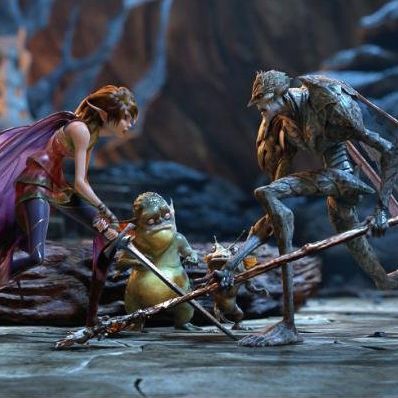
Strange Magic isn’t very magical, but it sure is strange. So many of today’s kids’ films, both good and bad, wear their inspirations on their sleeves. You can reenact the pitch meetings as you watch the movie, imagining what precise formula of previous hits mashed together gave rise to it. (Last year’s The Lego Movie brilliantly mocked such derivativeness, even as it shamelessly indulged in it.) But it’s rare to find a film that bounces around so weirdly, so uncomfortably between influences and subgenres as Strange Magic does. Then again, it was co-written and executive-produced by George Lucas, a man who both dreams big and borrows big. And here, he borrows relentlessly from modern pop (the film is filled with new versions of hit songs), Shakespeare, Disney, Pixar, James Cameron, and himself. You can sense his constantly grasping mind behind the movie — in the way it appropriates disparate elements of both high and low culture to create something … well, not new, exactly, and certainly not original, but definitely, um, insistent.
The film opens with a map unfolding to set the stage for its fantasy world. Two lands exist side by side, a bright, colorful Fairy Kingdom, and a grim, forbidding Dark Forest, yadda yadda yadda. Magical primroses grow along the border, used to make a love potion that can make anyone who drinks it fall for the first creature they see. This whole world is populated by talking fairies and slugs and insects and strange, goblin-y things, not unlike Epic from a couple of years ago. When we first meet our adventurous fairy heroine Marianne (voiced by Evan Rachel Wood), she’s singing “Can’t Help Falling in Love” amid the flowers, flying around dodging dragonflies as she prepares to marry the hunky, dim, vain Roland (voiced by Sam Palladio). Spying her beau messing around with another fairy, however, Marianne decides she’s through with love. (Cue “I’ll Never Fall in Love.”)
Her younger, bubblier (and blonder) sister Dawn, however, remains idealistic and sweet. Meanwhile, in the Dark Forest, the scaly, gruesome, terrifying Bog King (voiced by Alan Cumming) has his minions keeping an eye on the primroses along the border, to guard against the creation of the love potion; he’s even keeping the magical creature that creates the potion, the Sugar Plum Fairy (Kristin Chenoweth), captive in his forest to prevent the love from getting around. “No primroses, no potion. No potion, no love. Because love is dangerous … It destroys order. And without order, what’s left? CHAOS!”
That’s the fairly predictable setup, and the rest of Strange Magic’s wildly convoluted yet obvious plot involves the various machinations by which the two fairy sisters, Roland, and the Bog King’s destinies become intertwined. Along the way, various popular songs — “Crazy Little Thing Called Love,” “I Can’t Live (If Living Is Without You),” etc. — are given the wedding-band treatment, presented to us in inferior, Broadway-ized, off-tempo versions with little novelty or charm. (Though I will grant that the idea of turning the opening bars of “Bad Romance” into an invading army’s war chant is inspired.) We can tell fairly early on that the whole thing is leading to the headstrong Marianne and the melancholy Bog King finding true love — a riff on Beauty and the Beast — and it’s odd to see the film jump through so many hoops and awkwardly rope in so many characters in order to bring these two together, to manhandle this unlikely love into place.
The problem with Strange Magic isn’t so much its derivative story as it is the odd, half-complete way it unfolds. You can sense the weird mixture of tones, influences, ideas — as if the whole thing were still in its planning stages. The simple, elemental way this fairy land is initially presented feels like the film might be aimed at younger kids, but most of those kids will probably be confused and put off by the shrill storytelling, the blurry confusion of characters, the wink-wink hopscotching around the jukebox. (At times, one wonders if Lucas isn’t going for an American Graffiti feel with the soundtrack. But the pop songs in that film fed into its milieu of generational unease and its elegiac portrait of a world about to be obliterated by Vietnam. Here … not so much.)
Still, there’s an interesting idea at the heart of it all. The Bog King fears that love brings chaos, and that chaos, when it does come, is actually rather charming. One of the stated inspirations for the film is Shakespeare’s A Midsummer Night’s Dream, and when the love potion eventually gets out of hand (as we always knew it would), Strange Magic briefly lives up to its title, with various characters — rodents, fungi, fairies, and insects — falling for each other in offbeat combinations. For one shining moment, this trippy, sylvan world of ornate plants and gooey, scaly creatures becomes something fascinating and sweet. I can’t really recommend Strange Magic, but there’s something to be said for a movie that has a weird, giant love-in where the climactic battle should be.


